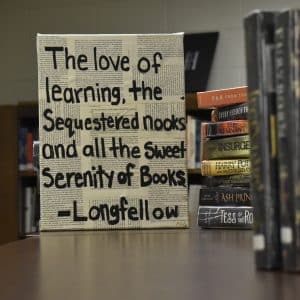The Role of Libraries in School Transformation
Education Domain Blog

As schools and institutions have begun transitioning toward personalized and competency-based learning, there is an old-fashioned stalwart that is often underused during the transformation process — the school library. School libraries have always been seen as quiet sanctuaries for reading and as book depositories, but definitely not hubs for innovation. In some cash-strapped districts, libraries have even come under the chopping block as budget deficits force administrations to seek out and eliminate or cut positions and programs.
In a learner-centered paradigm, libraries serve an important purpose, for one of their main commitments is to cultivate self-interest in learners and equip them with the skills to independently evaluate sources of information. Materials that libraries supply for students — books, computers, audiobooks, microfiche, etc. — are all just mediums for the transfer of information. Librarians act not only as guides to assist students in finding materials that are suitable to their academic goals and interests, but also as an arbiter of the sources to which students are given access.
Librarians also act as advocates for lifelong reading, as essential partners to teachers, and as guides to help learners find appropriate reading materials. In a competency-based system, learners are all on different reading levels, so librarians provide critical support to help individual students find a book that is both appropriate for their interests and reading level but also for what their classroom teacher has set as the learning objective. Some library management software systems, such as Follett Destiny, allow teachers to create reading lists based on the school’s card catalog for their learners. This allows learners to preview a curated list of materials available to them for supplementary support.
Librarians are experts in myriad skills and subjects, making them excellent partners in developing and implementing projects and helping determine mastery of competencies. Librarians are also generous collaborators who should be encouraged by administrators to have the freedom to transform their spaces into a place where learners can feel comfortable and build knowledge and competencies.
Libraries are shaped with equity. Materials purchased for school libraries are suggested by stakeholders on every level. Teachers can also suggest materials to supplement instruction. Importantly, learners can suggest books on topics that are of personal interest to them but that they may not feel comfortable addressing in front of others. Librarians never have to act as a judge of student performance, so relationships can be built between librarians and learners in a way that is different from the teacher–learner dynamic. This relationship-building gives students an additional advocate in the building they can talk to about personal issues and receive resources without anyone else knowing.
The first three sections of the American Library Association Code of Ethics are about equity and patron privacy, demonstrating the library’s dedication to serving all learners as people first. This culture of acceptance and understanding helps develop a place of civil discourse between learners and leaders of all ages, religions, and income levels. This even playing field gives students the social capital needed to act as citizens in our participatory democracy.
Public libraries are also amazing resources for schools looking to improve their work in a learner-centered, competency-based system. They provide access to technology and resources for learners outside of the school day. Creating partnerships with public libraries can help provide students with the resources that they require while also giving them access to professional librarians and community members.
Public libraries are also developed through equity. The entire community helps develop the collection, especially with materials created about their region and by local authors, which helps students understand the culture of their community. Public libraries are built by the collective voices of a community but are designed to cater to the needs of the individual.
Unfortunately, public libraries can also be the victims of budget shortfalls and cuts, so creating resource-sharing partnerships can help benefit both schools and their community library. Developing partnerships with public libraries also helps familiarize learners with library services that can help better their chances of becoming library patrons after graduation.
As traditional schools create their plans for how to innovate and transform, libraries, both school and public, can and should act as a key piece in the design. Libraries are malleable. They can retain the conventional purpose of storing resources and information for learners while advocating for literature and being transformed into makerspaces, learning commons, archives, and design labs.
Dustin Hensley (@Dustinhensley12) is the Library Media Specialist at Elizabethton High School in Elizabethton, TN. He was one of the co-founders of the Bartleby Program, one of the winners of the XQ Super School competition and remains active in the XQ Community of Practice. He currently teaches courses on community improvement and academic research and is developing a class for engaging students in public history. He can be reached at [email protected] for inquiries or general discussion about libraries, student voice, and transforming education.